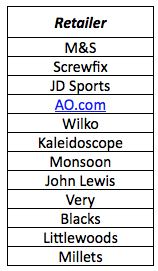Researchers have been analysing how easily UK consumers can get in touch with retailers via their preferred channel and they have identified a ‘dutiful dozen’ retailers that are ticking all the boxes. With 81% of consumers taking their business elsewhere if their queries aren’t answered quickly and effectively by a company, it is critical that retailers are offering a great customer experience and as many customer service touchpoints as possible. Chris Robinson explores the evidence.
A great customer experience is quickly overtaking price to become the key brand differentiator for consumers. Within this, of course, the service they receive is an enormous influencer for how people feel about an organisation. But, as online purchases continue to increase across all consumer-facing sectors, expectations of a great customer experience across the channels now open to them is already high and growing steadily higher.
The beauty of the internet for today’s consumer is the opportunity it affords to make purchases at a time to suit them, day or night. Understandably, when people can buy an item or service in a matter of minutes and through just a few clicks, they also expect answers to any questions they may have just as quickly.
Ask a consumer what it takes for a company to come out on top, and how easy they are to get in touch with along with how quickly and efficiently they resolve queries or issues will be right up there along with price and product quality.
The likes of Amazon and first direct frequently rank at the top of customer satisfaction surveys perhaps because, as online-only brands, providing a seamless digital customer experience has always been key to their success. Other companies expanding their offline offering online are still playing catch up, yet with research showing that 32% of people will turn to an alternative immediately if their expectations for a response time to a query are not met (according to a report by Magnetic North), businesses in all consumer-facing sectors would be wise to take note.
 A great customer experience: satisfaction and the bottom line
A great customer experience: satisfaction and the bottom line
In fact, Institute of Customer Service analysis of customer satisfaction and financial performance in organisations across nine sectors between 2008 and 2016, shows those that maintained higher customer satisfaction than their sector average achieved stronger turnover growth and profit than those that didn’t. It also notes that in its most recent customer service rankings, the most significant differences between the highest performing organisations and the rest focused around the number of problems and complaints, how they are handled, over the phone experiences and perceptions of openness and transparency.
Yonder Digital Group recently commissioned its own research analysing how easily UK consumers could get in touch with 100 top retailers in the UK and the contact methods on offer. Twelve brands stood out: John Lewis, M&S, AO.com, Screwfix, Monsoon, Kaleidoscope, Very, Blacks, Wilco, Millets, Littlewoods and JD Sports.
Balancing live and automated support
These are the organisations that continually offer a consistent and high level of customer support across all channels. So what does it take to be one of them?
Providing a great customer experience demands a multi-channel service offering that uses the technology available, both in terms of automated and live agent services, to meet customer expectations. Offering channel choice is key: in a 2017 Yonder Digital Group report, 84% of those questioned on the subject said they tended to stay more loyal and to do more business with companies that provided multiple touchpoints.
Linked with this, fast query resolution is also critical. Customers vote with their feet and organisations that fail to satisfy these expectations will find their share of wallet diminishing as unhappy customers move on to the next business that ticks those customer service boxes. Research from Zendesk shows that, in fact, more than half of consumers stop buying after a poor customer service interaction and that 95% share bad experiences, so providing multiple, equally well-serviced touchpoints is vital for retention and the bottom line.
Understanding that a switched-on multi-channel approach is needed is only the first step: getting it right entails identifying where automated and live services provide the best fit. Chatbots, live chat, online query forms, social media, email and phone all have their benefits, but retailers also need to ensure they strike the right balance between using live and automated channels.
Automated services are certainly hugely effective and can provide the fast response that consumers expect. However, with a drive towards greater automation in so many areas of both business and personal life and the growing role of AI, it may seem logical to implement as much of this as possible. But there are times when only the human touch will do, such as in the event of a complaint, or a non-standard enquiry. Failing to offer live agent interaction can drive customers away, with previous Yonder-commissioned research showing that 69% of people will go elsewhere if this is not offered when they have a query.
Analyse the customer journey
Rather than providing live agents 24/7 or only between the standard opening hours of nine and five, a more cost-effective and efficient route involves firstly an analysis of the customer journey to identify the most popular times for queries to come through, as well as common times for basket abandonment and the receipt of customer communications. With people increasingly shopping online in the evenings, for example, brands may find this a busier time for queries than earlier in the day.
In addition, looking at retention and defection rates can also help to build up a picture of how well an approach is performing. This data can then be used to determine the tools that may be most appropriate during which periods of the day and what therefore to implement where and when in order to strike the right balance between live agent support and automation.
Providing the kind of customer experience that people want to share with others and that inspires their loyalty certainly demands this balance of technology and the human touch. And with how well an organisation responds to its customers’ needs fast becoming the key differentiator for consumers looking for the best place to shop, it is an area that increasingly needs to be a priority for consumer-facing sectors.
Have an opinion on this article? Please join in the discussion: the GMA is a community of data driven marketers and YOUR opinion counts.


 A great customer experience: satisfaction and the bottom line
A great customer experience: satisfaction and the bottom line


Leave your thoughts